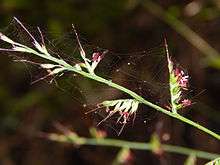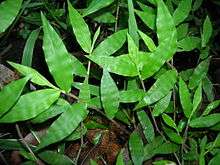Oplismenus hirtellus
Oplismenus hirtellus (commonly known as basket grass) is a flowering perennial plant from the family Poaceae that can be found on every continent in the world except Antarctica, growing mostly in coastal tropic and subtropic regions as well as tropical and subtropical islands such as Hawaii, New Zealand, Australia and Madagascar.[1]

| Basket grass | |
|---|---|
 | |
| Scientific classification | |
| Kingdom: | Plantae |
| Clade: | Tracheophytes |
| Clade: | Angiosperms |
| Clade: | Monocots |
| Clade: | Commelinids |
| Order: | Poales |
| Family: | Poaceae |
| Subfamily: | Panicoideae |
| Genus: | Oplismenus |
| Species: | O. hirtellus |
| Binomial name | |
| Oplismenus hirtellus | |
Description
The species flowering stalk is located 200 millimetres (7.9 in) above the leaves with the sticky purple colored awns. Flowers appear from December to June.[2] It grows 0.3 metres (1 ft 0 in) high and has some hairs which have 10-15 nerves on either side. The plant is whitish on the lower surface and is very narrow near midrib.
It is self-pollinated plant which seeds attract various animals and birds. The sticky seeds are easily distributed by animals and humans, easily adhering to fur and clothing.[2]
Distribution
In the United States
Oplismenus hirtellus is considered native to the southeastern United States,[3] growing in Alabama, Arkansas, Florida, Georgia, Louisiana, Mississippi, North Carolina, South Carolina, Texas, and Oklahoma.[4]
There has been some disagreement about the taxonomic classification of non-native Oplismenus in several states:
- In Maryland and Virginia an exotic invasive Oplismenus with white flowers was discovered in 1996 and identified as Oplismenus hirtellus subsp. undulatifolius but later recognized as the separate Oplismenus undulatifolius.
- In Hawaii, the grass was recorded in 1819 though not considered native to the state.[5] With deep reddish flowers, the Hawaiian grass is most likely a form of the tropical Oplismenus hirtellus rather than the temperate O. undulatifolius. Because of its presence on the islands for over 150 years, it is referred to as a naturalized non-native, while its dominance in shaded forests suggests the species could be described as invasive.[6]
References
- "Discover Life: Point Map of Oplismenus hirtellus". Encyclopedia of Life. Retrieved November 10, 2015.
- "Oplismenus hirtellus (L.) P.Beauv". PlantZAfrica.com. Retrieved May 14, 2013.
- "Oplismenus hirtellus (Retz.) P. Beauv. Burmann's basketgrass". USDA. PLANTS Profile. Retrieved May 14, 2013.
- "Oplismenus hirtellus (L.) P. Beauv. subsp. setarius (Lam.) Mez ex Ekman". National Plant Germplasm System. Retrieved 7 January 2016.
- Motooka, P.; et al. "Oplismenus hirtellus" (PDF). Weeds of Hawai‘i’s Pastures and Natural Areas. College of Tropical Agriculture and Human Resources, University of Hawai‘i at Mänoa. Retrieved 7 January 2016.
- "Weed Risk Assessment for Oplismenus hirtellus (L.) P. Beauv. subsp. undulatifolius (Ard.) U. Scholz (Poaceae)" (PDF). APHIS. United States Department of Agriculture. Retrieved 7 January 2016.
Further reading
- Gibbs Russell, G.E.; et al. (1990). Grasses of southern Africa. Memoirs of the Botanical Survey of South Africa. 58.
- Van Wyk, E. & Van Oudtshoorn, F (1999). Guide to the grasses of southern Africa. Pretoria: Briza Publications.
External links
- Dressler, S.; Schmidt, M. & Zizka, G. (2014). "Oplismenus hirtellus". African plants – a Photo Guide. Frankfurt/Main: Forschungsinstitut Senckenberg.